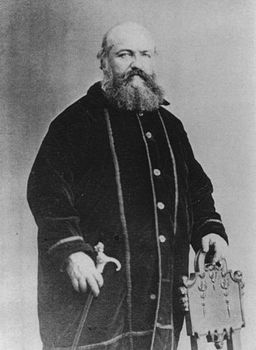
Tarot & the Occult Revival: From Eliphas Lévi to the Golden Dawn
Introduction: A Turning Point for Western Mysticism
Today, tarot is often seen as a personal tool for insight, manifestation, or even daily inspiration. But the foundations of modern tarot lie in a powerful period known as the Occult Revival — an era that reshaped Western esotericism and established the tarot as more than a fortune-telling parlor game.
Much of what serious practitioners work with today — from attributions of Hebrew letters to planetary correspondences — originates in the intellectual ferment of the 19th century. This was the age of Eliphas Lévi, the Hermetic Order of the Golden Dawn, and the flowering of ceremonial magick that still informs how we read, study, and internalize the tarot.
Eliphas Lévi & The Birth of the Modern Tarot Mystique
French occultist Eliphas Lévi (1810-1875) is often credited with being the first to explicitly connect the tarot with the Qabalah, suggesting that the 22 trumps of the Major Arcana correspond to the 22 paths of the Tree of Life.
In his influential work The History of Magic, Lévi wrote that “the Jews drew from Egypt the secrets of the Magi and transmitted them, altered and often disfigured, to the profane through the mysteries of the Tarot.” For Lévi, the tarot was a portable book of arcane wisdom, preserving initiatory truths hidden within symbolic images.
He layered the cards with meanings drawn from astrology, alchemy, and biblical mysteries — treating the tarot less as a fortune-teller’s deck and more as a magical glyph system, capable of unlocking higher realities when properly meditated upon.
The Golden Dawn: A Complete Magical System
Building on Lévi’s ideas, the founders of the Hermetic Order of the Golden Dawn — MacGregor Mathers, William Wynn Westcott, and others — codified the tarot’s place in Western esoteric practice.
Unlike earlier dabblers, the Golden Dawn integrated the tarot into a fully fleshed out system of ceremonial magick, tightly linked with the Tree of Life, planetary forces, angelic hierarchies, and elemental energies.
In their system:
- Each Major Arcana card is assigned to a Hebrew letter and thus to a path on the Tree of Life.
- The Minor Arcana are tied to the ten sephiroth across the four Qabalistic worlds, revealing not just outcomes but the architecture of creation itself.
- Tarot was used in ritual work, scrying, and as a meditative gateway — not simply laid out for predictive spreads.
Their curriculum for initiates included deep study of tarot imagery and its symbolic resonances, preparing the student to wield the cards as a true ritual tool.
Crowley & the New Aeon
Aleister Crowley, himself an initiate of the Golden Dawn before forging the A∴A∴, took this synthesis further. In his Book of Thoth, he reframed the tarot as an instrument of the New Aeon, reflecting the evolutionary current he proclaimed with the advent of the Aeon of Horus.
Crowley’s deck, illustrated by Frieda Harris, is laden with complex Qabalistic, astrological, and Thelemic symbolism. Cards like Lust (traditionally Strength) and The Aeon (Judgement) were consciously renamed and reimagined to reflect the new spiritual current. Crowley even famously reattributed Tzaddi to The Emperor rather than The Star, an adjustment he asserted was a rectification of an ancient error.
For modern practitioners, working with the Thoth tarot is often an act of ceremonial magick in itself, designed to initiate the reader into deeper mysteries.
How This Shapes Tarot Practice Today
Because of the occult revival, few serious tarot practitioners today look at the cards as simple fortune-telling tools. Even a straightforward Celtic Cross spread often draws unconsciously on the layered correspondences passed down from Lévi, the Golden Dawn, and Crowley.
- When we talk about the Fool as Aleph, the breath of spirit, we echo Lévi’s integration of the tarot and Qabalah.
- When we read the Majors as pathways between sephiroth, or the suits as expressions of elemental forces, we’re standing on the Golden Dawn’s intellectual scaffolding.
- When we meditate on the Thoth deck’s imagery, we engage with Crowley’s vision of tarot as an evolving current of spiritual consciousness.
This historical foundation isn’t just trivia — it’s what gives tarot its multi-dimensional power. To approach the cards today without some awareness of these occult lineages is to miss much of what makes tarot such a profound and flexible initiatory tool.
Conclusion: A Legacy That Continues to Unfold
The 19th and early 20th centuries transformed tarot from a game for aristocrats into a map of the soul. Thanks to Lévi, the Golden Dawn, and Crowley, the tarot became not only a symbolic book of wisdom but also a living ritual instrument, a mirror of cosmic order, and a personal portal to spiritual development.
Understanding this lineage doesn’t just make us better readers — it deepens our relationship with the cards, rooting each spread, meditation, or working in a tradition that has shaped modern esotericism itself.
Related Articles
How to Use Tarot for Meditation & Spiritual Growth
Discover how to use tarot as a powerful meditation tool. From simple daily focus to advanced Qabalistic pathworkings, learn how to let each card become a gateway to insight, healing, and spiritual growth.
How to Perform the Lesser Banishing Ritual of the Pentagram (LBRP)
Learn how to perform the Lesser Banishing Ritual of the Pentagram (LBRP) step-by-step. Discover its history in the Golden Dawn and Thelema, its spiritual meaning, and how modern students—both mystics and magicians—use it for balance, protection, and clarity.